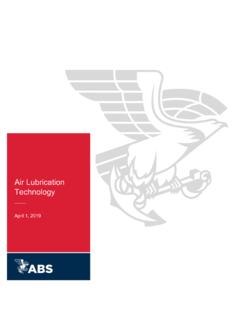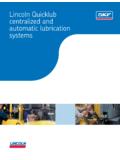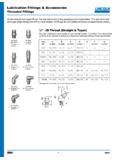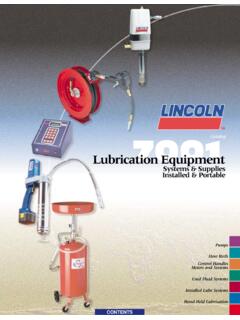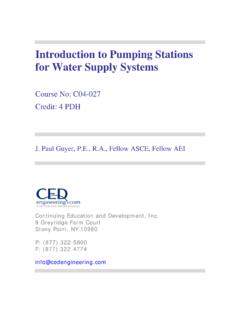Transcription of LUBRICATION Training Manual - Pulsarlube
1 Issue Number: 200711 LUBRICATION Training Manual Table of Contents Section Subject Content Page# 1. Introduction 4 Fundamentals of LUBRICATION 4 Oils Base Fluids 5 Minerals Synthetics 6 Viscosity Viscosity Index 9 Additives Review 11 Compatibility s 12 Greases 13 Grease Types 14 Soap Greases Non Soap Greases Additives Grease Ratings 15 Review 16 Compatibility s Open gear compounds 17 OG Lube Types Grease Compounds 18 Review 19 Compatibility s Module Review 20 Lubricants on site Module Review 22 2. Equipment, methods & procedures 27 Automatic lube systems Lincoln type 27 Tecalemit SLP type 29 Tecalemit XGS type 30 Pulsarlube 31 Issue Number: 200711 Manual systems 33 Grease guns Oil containers 34 Aerosol cans Drip oilers Hand operated pumps Oil sampling 35 Procedures Analysis results Module 2 Review 37 3 Safety & Housekeeping 39 Safety Lubricant exposure 40 High pressure air High pressure grease 41 Housekeeping 42 Cleaning up spills Oil & grease application Module 3 Review 44 Issue Number.
2 200711 1. Introduction This and subsequent LUBRICATION Training sessions are designed to provide a basic understanding of LUBRICATION principles and applications to workstation equipment. The subjects covered are designed to provide a "working knowledge" of lubricant types, purpose and application, compatibility s, housekeeping and automatic LUBRICATION systems. More detailed information is available on specific subjects such as gearing, bearings, automatic lube system components and lubricant design and will be provided on request of individuals. If any subject within this program requires further discussion following completion of the Training seminar, we would be pleased to provide clarification.
3 Fundamentals of LUBRICATION For applications at a typical industry, the majority of applications will be divided into three categories. These are; Oils Greases Compounds Oils Oils are by far the most important of all products used on site. They are formulated with specific base stocks and additive packages to perform to a given level. The finished product also forms the basis for other products such as greases and compounds. The most important thing to remember when discussing oil lubricants is that the oil is essentially the medium which performs the LUBRICATION function. It provides, in all cases a fluid wedge between moving parts (ie bearings, gears, slides) that are in relative motion.
4 The design of the oil is the most critical component of any finished lubricant. To explain the makeup of various oil lubricants we must separate their individual components and discuss them. Figure 1. Bearing Cross Section Figure 2. Lubricant Wedge Issue Number: 200711 Base Fluids There are many types of lubricant base fluids available and generally the design of the equipment, the operating environment, operating temperature, ambient temperature, speed, load and cost of the base fluid will determine which base fluid is chosen. The most common base fluids are; Mineral Paraffin Based Products Napthene Based Products Paraffin based products exhibit high film strength but contain relatively high levels of carbon and residual waxes.
5 Napthene based products contain very low levels of residual contaminants but have lower film strength than paraffin oils. Sometimes a blend of both types will be used to attempt to obtain the best characteristics of both types. Synthetics - SHC type - Diester type Polyalphaolefins are more commonly known as SHC or synthetic hydrocarbons. They are synthetic fluid which most closely resembles mineral oils (paraffin s) and exhibit the good qualities of the minerals with practically none of the shortcomings. They have excellent thermal stability, low pour points and are compatible with most mineral oils. (Though mixing with minerals will decrease their effectiveness).
6 Their limitations are generally that they have very limited detergency and that they may have adverse effects on some common seal materials, plus higher cost than mineral oils. Diesters and Polyolesters are organic esters which have been in use since the 1940's. They are very clean lubricants and exhibit excellent thermal and oxidation resistance but have a more severe effect on seal materials than most other synthetics. They are typically used in high temperature chain & compressor applications There are many other types of synthetics, these can include: PAG Polyalkaleneglycol SI Silicone F/CL Halogenated Viscosity & Viscosity Index.
7 Regardless of fluid type chosen, the viscosity at operating and ambient temperature is the most critical feature of the lubricant for a particular application. Some general rules are; use High Viscosity base fluid products for slow moving, heavily loaded and/or high temperature applications. use Low Viscosity base fluid products for fast moving, lightly loaded and/or low temperature applications. Issue Number: 200711 The purpose of any lubricant is to separate moving parts. The degree of separation is generally accepted to be required to be between to 4 times the combined surface roughness of the finished metal components.
8 Large (comparatively) roughly finished open gearing requires a higher viscosity. Fast moving highly polished bearings or gears require a lower viscosity. If the incorrect viscosity base fluid is used to lubricate machinery, operational problems will usually occur. These can be; overheating of bearings in applications where too high a viscosity is used ; accelerated wear of bearings and gears when too low a viscosity is used. Viscosity Index is the amount or rate at which a fluid changes viscosity at either high or low temperatures. It is particularly important in cold climates or in hot environments. Minerals generally have a low VI while synthetics have varying degrees of higher VI.
9 Figure 1. High Viscosity Fluids Flow Slowly Figure 2. Low Viscosity Fluids Flow Quickly Figure 1. High Viscosity Fluids Figure 2. Low Viscosity Fluids Issue Number: 200711 Figure 1. Low Viscosity Index Oil Figure 2. High Viscosity Index Oil Issue Number: 200711 Viscosity s of different oil lubricants are classified by several authorities. The most common are; ISO International Standards Organisation. Measures in cSt @ 40 C. SAE Society of Automotive Engineers. Measures in SUS (Saybolt universal seconds @ 100 F/210 F). AGMA American Gear Manufacturers Association. Measures in a numbered sequence for separate ISO or SAE requirements and identifies the need for extreme pressure additives.
10 Viscosity Comparison Chart Issue Number: 200711 Additives Additives are chemical, mineral or solid compounds that are "added" to the base fluid to enhance or change its properties. There are two classifications of additives; performance and non performance. Performance additives generally enhance the performance of the lubricant. Non performance additives are generally included to keep the product in place or to extend it s useful service life under adverse conditions. The most common "non performance" additives designed to extend the life of the lubricant are; 1. anti oxidants : to extend the life of the oil 2.

